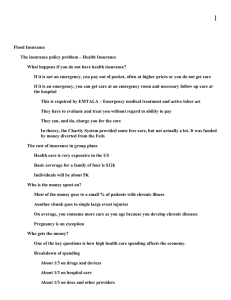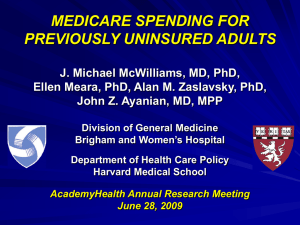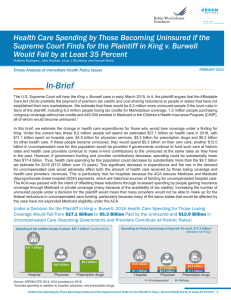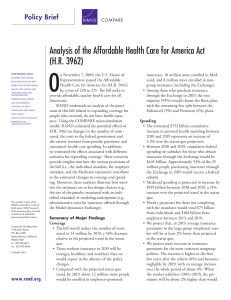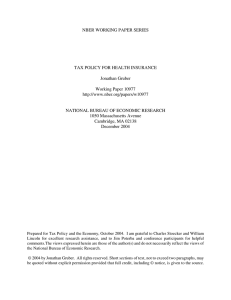Rising Health Care Costs: Can we Move Towards Higher-Value Care? Katherine Baicker
advertisement
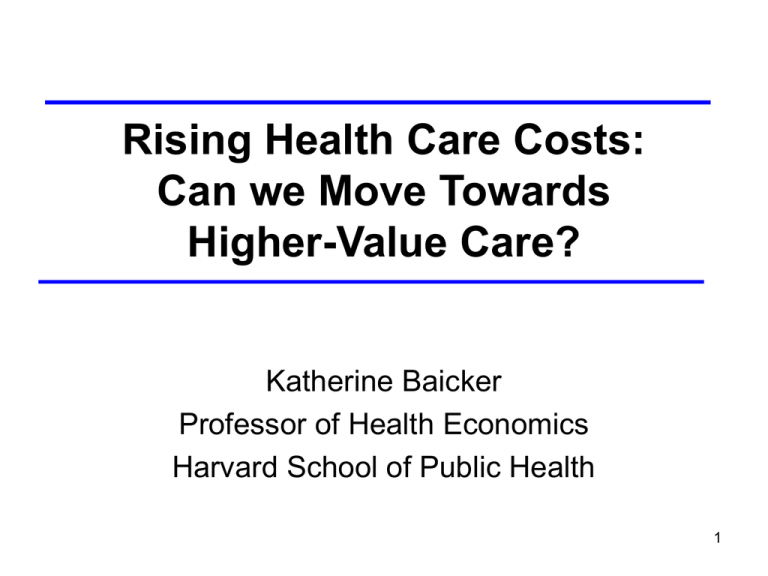
Rising Health Care Costs: Can we Move Towards Higher-Value Care? Katherine Baicker Professor of Health Economics Harvard School of Public Health 1 Lower Costs vs. Higher Value • Rising costs and uninsurance have made reform a priority, but should be focused on value, not just costs – Higher spending driven not by changes in number of physician visits or hospitalizations, but by intensity of treatment – Many payment schemes encourage quantity, not quality – Dulled incentive to develop cost-saving technologies • Appeal of cost-saving quality improvements – Self-financing plans to cover the uninsured – Health-improving reductions in spending – Elimination of waste, fraud, and abuse • But is this the right metric? – Worthwhile reforms that improve value may or may not save money 2 Ample Evidence of Inefficient Spending • International evidence: – Spend much more than OECD trading partners without commensurately better outcomes Infant Mortality Rates (per 1,000 Live Births) by OECD Country, 1960-2003 Internation Comparison Health Expenditures as a Share of GDP Percentage of GDP Deaths per 1,000 Live Births 35 16 United States 30 Canada Germany Japan United Kingdom United States 14 12 Canada France 25 10 Japan Sweden United States 20 Switzerland Median 8 15 6 10 4 5 2 0 1960 0 1960 1965 1970 1975 1980 1985 1990 1995 2000 1965 1970 1975 1980 1985 1990 1995 2000 Source: OECD Source: OECD • Domestic evidence: – Areas where we spend more are not areas with best outcomes 3 Quality Variation Even within Medicare Source: Dartmouth Atlas of Health Care 4 Variation in Medicare Spending Source: Dartmouth Atlas of Health Care 5 Higher Spending Does Not Necessarily Lead to Higher Quality Source: Baicker and Chandra (Health Affairs 2004) 6 Some Causes of Inefficiency • Public side: – Medicare reimbursement primarily based on quantity, not quality – Resources for the uninsured spent on inefficient modes of care • Private side: – Biases in tax subsidy of employment-based insurance – Barriers to well-functioning insurance markets – Information on prices and quality often not available 7 Consequences of Inefficient Spending • Health care dollars not allocated to highest value uses – Reimbursement rates drive health consumption decisions – Rising ranks of uninsured break down risk-pooling and lead to inefficient care for uninsured • Slower wage growth – Rising health insurance premiums have reduced wage growth by as much as 25% in the past five years – May exacerbate job-lock • Increasing pressure on taxpayers to finance governmentprovided insurance – Rapidly rising deadweight loss – Current path of spending growth is unsustainable 8 The President’s Proposal • Standard Deduction for Health Insurance – Anyone covered by a private policy would get standard deduction (regardless of source or premium) – Replaces current exclusion of employment-based insurance – Goal of eliminating biases in the tax code and improving efficiency • Affordable Choices Initiative – Goal of giving states extra flexibility and resources to cover hard-to-insure poor and chronically ill • Ongoing efforts to expand access to information and affordable insurance 9 Evaluating Effects Uninsured • How many fewer uninsured people? Individual purchasers • Effect on non-group market? The New Standard Deduction for Health Insurance Makes the Tax Codes More Progressive Tax Change as a % of Income (2007) Percent 0.2 Quintiles 0.1 People insured through jobs • Effects on number covered, generosity of plans? 0.0 -0.1 -0.2 1st 2nd 3rd 4th 5th Top 10% Top 5% Top 1% -0.3 -0.4 -0.5 Budget • Overall effect on budget? • Distribution of benefits? • Effect on growth of health spending? -0.6 -0.7 Note: Quintiles begin at: 2nd $13,310; 3rd $28,507 ; 4th $50,448; 5th $87,758; top 10% $128,676; top 5% $177,816; top 1% $432,275. Source: U.S. Department of the Treasury, Office of Tax Analysis. Quality • Effect on value of care and insurance? 10 Other Proposals • Reforming tax-treatment of health insurance plays major role in many (Republican) candidates’ proposals – Variants include refundable tax credit • Clearly only one piece of puzzle – Many cost-containment proposals focus on low-hanging fruit, but can’t count on covering uninsured, saving lives, and saving money – Focusing on combination of value-improving strategies that have system-wide effects likely to generate most bang for the buck 11 Focus on Changes with System-wide Effects • Interventions that affect the care received by some groups likely to have “spillover” effects – – – – Insurance coverage – extent and type Use of high-intensity interventions Information Use of “best practices” • Few individual interventions likely to produce better health at lower cost – Doesn’t mean there aren’t many worthwhile interventions – Probably willing to pay more if getting a lot more health for it 12
